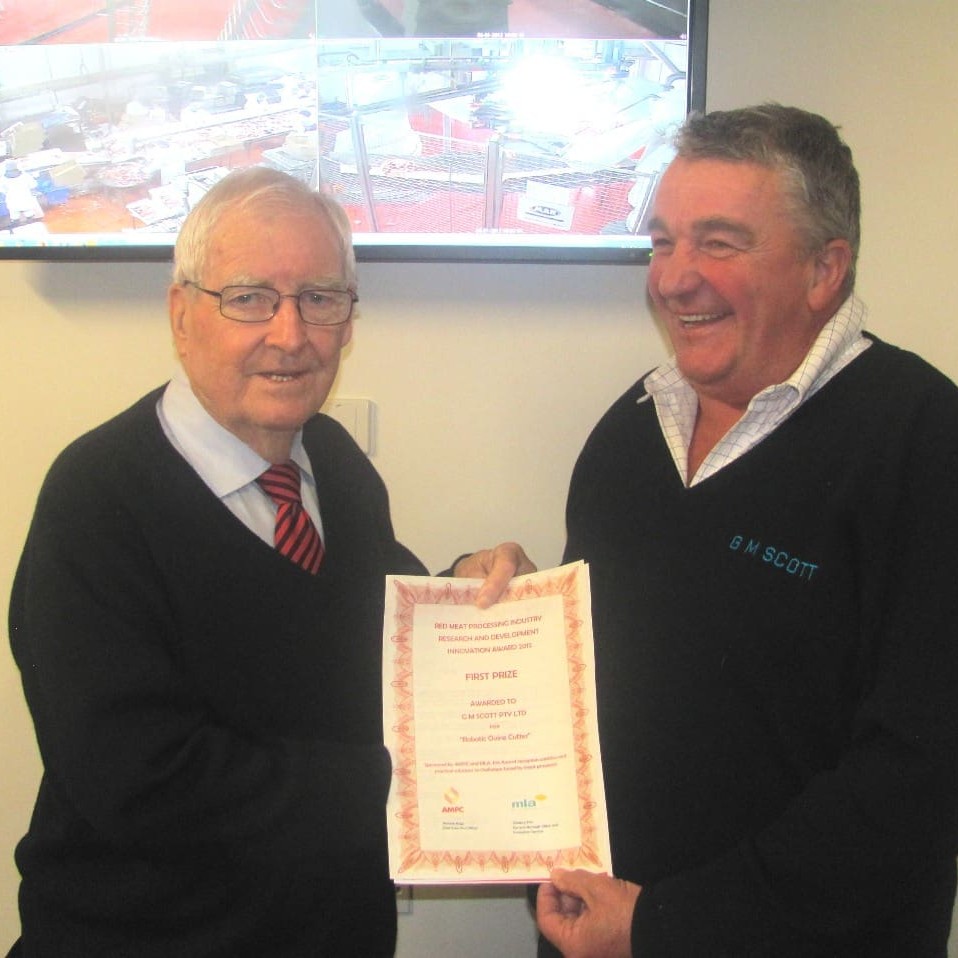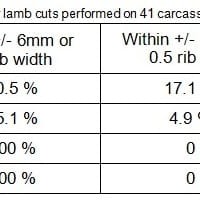 The GM Scott lamb and beef processing plant at Cootamundra in NSW has received a significant industry accolade, earning the 2012 Australian Meat Processors Corporation Innovation Award for its development work with a robotic carcase cutter.
The GM Scott lamb and beef processing plant at Cootamundra in NSW has received a significant industry accolade, earning the 2012 Australian Meat Processors Corporation Innovation Award for its development work with a robotic carcase cutter.
The GM Scott abattoir has the capacity to process about 200 cattle and 3800 lambs daily, principally supplying supermarket group, Woolworths.
The company received the award at AMPC’s 2012 Red Meat Processing Industry Conference in Sydney last week.
After considerable development work, the current version of the robotic boning room aid now manages four cuts per carcase, at a rate of more than 360 carcases per hour.
The Robotic Ovine Cutter (ROC) system increases the accuracy of cut and reduces bone-dust when compared to a bandsaw, which is more conventionally used for this purpose, resulting in increased yield.
Coupled with the reduction in Occupational Health & Safety risks due to decreased bandsaw operations and increased output, this has allowed GM Scott to begin to streamline its boning room operations. The process also reduces risk of cross-contamination from one carcase to another.
The ROC system had its origins in a prototype installation at Midfield Meats in Victoria around 2006, which was capable of making two cuts per carcase. A Processor-Initiated Project (PIP) was established with the aim of increasing the output from the system to 450 carcases per hour for two cuts, at GM Scott’s plant.
As well as comfortably achieving this requirement, with further minor adjustment and fabrication, the current ROC now accurately performs four carcase cuts (shoulder, middle, leg and chump) at a rate of 360 carcases an hour. This four-cut system is the first of its kind worldwide to achieve these specifications.
The system utilises vision-profiling and dustless blade-cutting technology to provide accurate carcase analysis, and produces outstanding cutting efficiencies.

The results above show criteria were met for the Middle Cut, Leg Cut and Chump Cut. The Shoulder cut achieved an accuracy of 97.6pc within plus-or-minus 10mm (98pc specified). Discussions with GM Scott indicated that the single carcase out of the 41 analysed that had the shoulder cut out by more than 10mm was a particularly large carcase and probably out of the normal weight range for what is processed at the plant.
Speeds exceeding 450 carcases/hour were achieved for two cuts and 360 carcases/hour for four cuts.
The ROC primal cutting system has the flexibility to handle a wide range of carcases in the Ovine range, delivering accuracy to close tolerances.
The layout of the system was designed to fit in with other modifications occurring in GM Scott’s boning room. Increased speed was achieved by the addition of a third robot and further cuts were implemented with redesign of the carcase gripper and modifications to the Vision system algorithms.
The system installed at the plant consists of a number of inter-connected items:
- Three robots – two carcase-gripping units and one cutting unit
- In-feed and exit conveyors
- Carcase grippers and cutting blade
- Vision system
- Safety fencing
- Entry safety mat
- Blade wash tank, and
- Operator control panel.
The robots have a 205kg payload and 2.75 metre reach capability. Two robots are fitted with carcase grippers while the third is fitted with the cutting saw motor and blade. Each of the robots is covered with a white protective bag custom-made from flexible material designed to fit each unit and protect it during wash-down conditions.
The cutting blade and saw utilise a Freund motor and dustless blade. Mounting plates to support the saw motor and prevent movement of the blade during operation were fabricated and integrated into the roll-face adaptor. The dustless blade allows clean cutting of the carcases, producing minimal bone dust and dramatically increasing the shelf-life of the meat
Conclusions drawn from the experiences at GM Scott suggest the ROC 450 system can have significant impact on the meat and livestock industry immediately and over the next five years.
Use of the robot eliminates up to four bandsaw cuts that would otherwise have to be made manually by a bandsaw operator. At the current speed above 380 carcases /hour at four cuts, the GM Scott boning room currently struggles to keep pace with the production rate. With further refinement and tuning of the system, however, it is anticipated that speeds of 600 carcases/hour could be achieved for three cuts.
